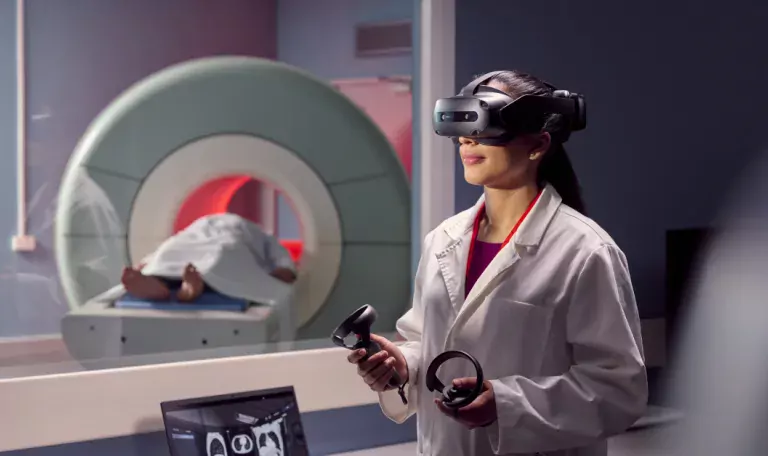How Hospitals of the Future Can Deliver More Convenient and Connected Patient Experiences
The shift to patient-centered care has elevated the importance of creating better patient experiences. Together with the transition to value-based delivery and the consumerization of healthcare, this evolution is driving changes in the patient care journey. From hospital admission to bedside care to billing, patients expect more — including improved convenience, digital communication with providers, and personalized customer service.
People-centric technology plays a prominent role in delivering on these evolving patient expectations. When Deloitte surveyed a collection of health system technology officers, 92% said that patient satisfaction and engagement is the top outcome they want from digital transformation — and 88% are making their biggest investments in patient experiences. 1
Lenovo’s versatile, end-to-end healthcare solutions enable healthcare systems to reimagine the patient journey and enhance bedside care. These solutions are powered by the built-for-business Intel vPro® platform — delivering industry-leading performance, modern management options, and robust security. Solutions such as Intel vPro® powered ThinkPad® T14 Gen 3 laptop, ThinkCentre® Tiny and Tiny-in-One desktops, and ThinkPad® X1 Yoga Gen 8 detachable tablet are part of a technology ecosystem that helps health systems modernize the care journey while creating more convenience and connected experiences for patients and clinicians.
Enhancing the Experience from the Moment Parents and Visitors Walk in
A survey by McKinsey & Company found that 90% of healthcare executives and 100% of chief marketing officers view healthcare consumerism as their organization’s top priority.2 As savvy consumers, patients often rely on recommendations from friends and family members. Emphasizing the importance of recommendations, clinical studies show that the patients’ experience affects both their satisfaction and their willingness to recommend a hospital.3
Patient experiences start long before they meet with their care teams. Ease of admission, for example, is one of the top patient experience criteria that impacts satisfaction.3 Hospitals and clinics can start patient experiences with a digital front door that includes information about providers, online patient forms, and patient education. Healthcare organizations can then provide seamless in-person check-in experiences such as self-service check-in kiosks to create positive impressions the moment patients walk into their waiting room. Technology that’s purpose-built for data-intensive computing not only provides this convenience for patients, but also improves back-office efficiency for staff who process intake forms and billing tasks.
Digital wayfinding can further improve the hospital visit for patients and visitors, helping reduce their stress of navigating the campus. Flexible way finding solutions offer the best value by adapting to different environments — from front entry kiosks and family waiting rooms to smaller spaces in patient rooms.
Improving In-Room or Bedside Care with Flexible Technology
Communication between patients and their care team plays a prevalent role in patient satisfaction, according to clinical research.4 Virtual and hybrid health models give clinicians the flexibility and convenience to connect with patients from anywhere. With healthcare collaboration technology, patients gain access to a wider care team including specialists, while providers can maintain face-to-face relationships both inside and outside of the hospital or clinic environment.
Virtual consultations also help clinicians:
• Focus more of their valuable time on patient care
• Connect with patients across large hospital campuses
• Boost productivity and clinical efficiency
• Maintain continuity of care and patient trust
Digital signage further enhances bedside care by providing important information to patients and family members. By replacing dry-erase boards with digital signage in recovery rooms, hospitals can communicate information in a timely fashion — such as the patients’ medication schedule and care team information during each shift.
Education also has a positive impact on the patients’ experience, while their satisfaction with inpatient care and discharge planning has shown decreased risk of readmission.4 With digital signage and infotainment tablets, providers can share important health education and discharge planning messages more effectively.
Empowering Parents through Connected Rooms
Keeping patients and family members engaged improves the patients’ care ratings in satisfaction surveys and positively affects outcomes such as patient comfort and emotional health, according to an analysis by the U.S. Agency of Healthcare Research and Quality.5 Collaboration technology keeps patients connected with loved ones, ensuring family members remain important partners in the quality of care and recovery outcomes.
Additionally, devices such as tablets can provide patients with in-room entertainment, educational programming, and access to medical portals for important information during the hospital stay.
Designing the Hospital of the Future
Goshen Health is the perfect example of how healthcare systems can reimagine their patient rooms to elevate the patient experience and redesign clinical workspaces to boost caregiver collaboration and productivity. More than a century old, the nonprofit healthcare organization provides a variety of services at 40 locations across communities in northern Indiana. As part of a transformation initiative, Goshen Health modernized three patient floors at one of its hospitals.
The vision of Goshen Health was to harness the latest benefits of healthcare technology with the goal of augmenting the experience and improving outcomes for patients and clinicians alike. From smart beds and digital whiteboards to patient tablets, Goshen Health reimagined how care is delivered while also adopting technology that boosts provider satisfaction and efficiency.
Lenovo played an instrumental role in this transformation, offering flexible solutions that adapted to various environments. For example, Goshen Health selected Lenovo ThinkCentre® Tiny-in-One to accommodate small spaces in patient rooms and ThinkPad® T14 laptops to keep nurses and physicians productive on the go. Thanks to the partnership with Lenovo, Goshen Health has created the hospital of the future that supports its mission of improving the health of its communities through innovative, outstanding care provided by exceptional people who do exceptional work.
Modernizing Every Aspect of Care Delivery
Among healthcare executives surveyed by Accenture, 81% said their organization was accelerating the pace of digital transformation.6 Digital transformation is an opportunity for forward-thinking healthcare organizations to evolve in step with:
• The patients’ demand for consumer-like services and access
• The changing expectations of patients and providers for better engagement and experiences
• The shift of business models to value-based, hybrid care
Lenovo Health technology supports this evolution with an end-to-end approach, proven capabilities, and an Intel vPro® powered platform that delivers an unrivaled, world-class PC solution. Some of Lenovo’s purpose-built healthcare solutions include:
- ThinkCentre® Tiny and ThinkCentre® Tiny-in-One: versatile, reliable, powerhouse PCs and an all-in-one workstation that combine power, performance, security, and speed in a small, space saving form factor that offers sleek cord management and flexible mounting options for modular clinical environments — perfect for data-rich needs as well as tough environments and small spaces, including patient rooms, visitor areas, nursing stations, and operating rooms
- ThinkPad® T14 i: a laptop optimized for productivity and collaboration on the go in healthcare settings that require higher data security and privacy, along with rigorous infection prevention
- ThinkPad® X1 Yoga Gen 8: a high-performance, business Ultrabook™ that converts into four modes — laptop, stand, tent, and tablet — to keep providers productive from anywhere and to offer in-room education and entertainment for patients
- ThinkSmart Core Full Room Kit: a flexible solution that is designed to adapt to any space — from patient rooms to large conference rooms — and comes with the ThinkSmart Cam (Lenovo’s first AI camera) and the ThinkSmart Bar for premium audio
- Virtual desktop infrastructure (VDI): hosted in the cloud or on a centralized server, Lenovo VDI solutions help streamline clinical workflows for more responsive care and offer customizable clinician experiences while enhancing security
- ThinkEdge Computing: purpose-built solutions that simplify the deployment and management of the edge while providing clinicians with real-time patient data and analytics, alerting them of problems before they become more serious, and helping improve chronic disease management, elder care, and patient health programs
- TruScale Infrastructure Services: a broad portfolio of flexible, customizable DaaS and IaaS solutions that allow healthcare organizations to scale technology and maintain an up-to-date IT stack to run demanding clinical workflows and improve patient care without making large technology investments
As the patient journey and care delivery continue to evolve, healthcare technology must elevate the experience for patients and providers alike across the care continuum. Lenovo Health delivers a smarter way forward, empowering the patient-first hospital of the future to innovate with people-first technology. Learn about the possibilities at https://techtoday.lenovo.com/ww/en/solutions/healthcare.





